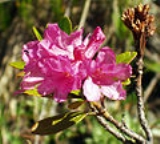
Rhododendron ferrugineum
Encyclopedia
Rhododendron ferrugineum (sometimes called alpenrose, snow-rose, or rusty-leaved alpenrose) is an evergreen
shrub
that grows just above the tree line in the Alps
, Pyrenees
, Jura
and northern Apennines
, on acid soils. It may grow up to 1 m tall and produces clusters of pinkish-red, bell-shaped flowers throughout the summer. The undersides of the leaves are covered in rust-brown spots, which give the species its scientific name. This is in contrast to Rhododendron hirsutum
, which has no such brown colouring, has hairy edges to the leaves and grows over limestone
. Where the two species co-occur (usually on soils of intermediate pH
, the hybrid Rhododendron × intermedium may occur; as its name suggests, it is intermediate in form between the two parental species.
R. ferrugineum is moderately toxic
, containing arbutine, aricoline and rhodoxanthine, and can cause vomiting
, and difficulties of the digestive
, nervous
, respiratory
and circulatory system
s.
Evergreen
In botany, an evergreen plant is a plant that has leaves in all seasons. This contrasts with deciduous plants, which completely lose their foliage during the winter or dry season.There are many different kinds of evergreen plants, both trees and shrubs...
shrub
Shrub
A shrub or bush is distinguished from a tree by its multiple stems and shorter height, usually under 5–6 m tall. A large number of plants may become either shrubs or trees, depending on the growing conditions they experience...
that grows just above the tree line in the Alps
Alps
The Alps is one of the great mountain range systems of Europe, stretching from Austria and Slovenia in the east through Italy, Switzerland, Liechtenstein and Germany to France in the west....
, Pyrenees
Pyrenees
The Pyrenees is a range of mountains in southwest Europe that forms a natural border between France and Spain...
, Jura
Jura mountains
The Jura Mountains are a small mountain range located north of the Alps, separating the Rhine and Rhone rivers and forming part of the watershed of each...
and northern Apennines
Apennine mountains
The Apennines or Apennine Mountains or Greek oros but just as often used alone as a noun. The ancient Greeks and Romans typically but not always used "mountain" in the singular to mean one or a range; thus, "the Apennine mountain" refers to the entire chain and is translated "the Apennine...
, on acid soils. It may grow up to 1 m tall and produces clusters of pinkish-red, bell-shaped flowers throughout the summer. The undersides of the leaves are covered in rust-brown spots, which give the species its scientific name. This is in contrast to Rhododendron hirsutum
Rhododendron hirsutum
Hairy Alpenrose or Rhododendron hirsutum is one of the species of rhododendron native to the mountains of Europe. It occurs in the eastern and central Alps, in the Tatra and the Balkans. It grows on carbonate-rich soils....
, which has no such brown colouring, has hairy edges to the leaves and grows over limestone
Limestone
Limestone is a sedimentary rock composed largely of the minerals calcite and aragonite, which are different crystal forms of calcium carbonate . Many limestones are composed from skeletal fragments of marine organisms such as coral or foraminifera....
. Where the two species co-occur (usually on soils of intermediate pH
PH
In chemistry, pH is a measure of the acidity or basicity of an aqueous solution. Pure water is said to be neutral, with a pH close to 7.0 at . Solutions with a pH less than 7 are said to be acidic and solutions with a pH greater than 7 are basic or alkaline...
, the hybrid Rhododendron × intermedium may occur; as its name suggests, it is intermediate in form between the two parental species.
R. ferrugineum is moderately toxic
Toxicity
Toxicity is the degree to which a substance can damage a living or non-living organisms. Toxicity can refer to the effect on a whole organism, such as an animal, bacterium, or plant, as well as the effect on a substructure of the organism, such as a cell or an organ , such as the liver...
, containing arbutine, aricoline and rhodoxanthine, and can cause vomiting
Vomiting
Vomiting is the forceful expulsion of the contents of one's stomach through the mouth and sometimes the nose...
, and difficulties of the digestive
Gastrointestinal tract
The human gastrointestinal tract refers to the stomach and intestine, and sometimes to all the structures from the mouth to the anus. ....
, nervous
Nervous system
The nervous system is an organ system containing a network of specialized cells called neurons that coordinate the actions of an animal and transmit signals between different parts of its body. In most animals the nervous system consists of two parts, central and peripheral. The central nervous...
, respiratory
Respiratory system
The respiratory system is the anatomical system of an organism that introduces respiratory gases to the interior and performs gas exchange. In humans and other mammals, the anatomical features of the respiratory system include airways, lungs, and the respiratory muscles...
and circulatory system
Circulatory system
The circulatory system is an organ system that passes nutrients , gases, hormones, blood cells, etc...
s.

